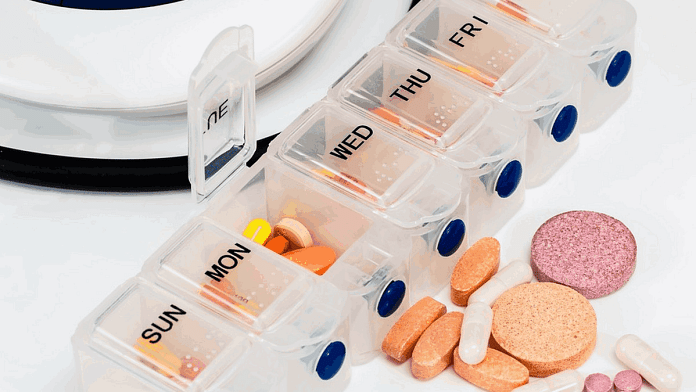New Delhi: The Joe Biden administration in the US has unveiled the names of the first 10 drugs subject to price negotiations under Medicare, a government-run national health insurance programme that primarily covers Americans aged 65 and above.
The medications set for price negotiations with manufacturers are used for treating heart diseases, some cancers, diabetes, blood clots and autoimmune diseases. These are Jardiance, Xarelto, Januvia, Eliquis, Farxiga, Entresto, Enbrel, Stelara, Imbruvica and insulin such as Fiasp.
These drugs, all under patent, are manufactured by pharmaceutical majors including Pfizer, Bristol Myers Squibb, Novo Nordisk, Boehringer Ingelheim and Eli Lilly and Company.
In a statement issued 29 August, the White House said that these ten drugs are among those with highest total spending under Medicare Part D, a sub-scheme to help the beneficiaries pay for self-administered prescription drugs.
“Millions of Part D enrollees depend on these vital treatments to treat life-threatening conditions including diabetes, heart failure, and cancer, but many struggle to access their medications because of prohibitive costs,” said the statement.
It further said that negotiations for the first group of selected drugs will begin this year and the negotiated prices will come into effect in 2026.
ThePrint explains the price negotiations, why the development has attracted global attention, and what it means for developing countries such as India.
Also read: Abbott recalls antacid Digene gel made in Goa facility after customer complaints
Drug price negotiations & pushback from pharma industry
Under Biden’s Inflation Reduction Act passed in 2022, the US government is aiming to negotiate with drugmakers the prices of a select number of drugs on which it spends the highest amount every year under Medicare, whose beneficiaries include nearly 66 million Americans.
Ashna Mehta, a health economist with The Public Health Foundation of India, a not-for-profit organisation in New Delhi that works on promoting public health policy, explained that the US has some of the highest prices of medicines globally.
“Price negotiations is an important step which is anticipated to result in considerable savings for the US government and especially benefit the elderly. Spillover effects on the commercial market can also be expected, even though there is pushback from the pharma industry,” she told ThePrint.
The agency that operates Medicare, Centers for Medicare & Medicaid Services (CMS), was not entitled to negotiate with drugmakers. But as part of the new law, the CMS aims to save $25 billion annually on drug costs by 2031, according to media reports.
Several drugmakers and business lobby groups, however, have already filed lawsuits against the programme. One of them, Boehringer Ingelheim, for instance, said in a statement on its website that the provisions under the Inflation Reduction Act will have detrimental effects on the future of biopharmaceutical innovation. But it added that it was “committed to engaging in open and transparent conversations with CMS”.
How the negotiations will happen
According to the Inflation Reduction Act, the negotiated prices should be at least 25 percent lower than the original list prices.
Drug manufacturers have till 1 October to agree to holding negotiations, failing which they may be asked to pay penalties. They have also been asked to submit, by 2 October, detailed data that the administration needs in order to come up with its proposed prices for the selected drugs.
The CMS plans to unveil its first offer prices by 1 February, 2024, and the manufacturers will be given a month’s time to come up with counter-offers. The price negotiations are slated to end by 1 August next year and Medicare will publish its list of new prices on 1 September, said media reports.
The whole process will be repeated in February 2025 when the CMS selects 15 other prescription drugs for negotiations, with new prices on those going into effect in 2027.
In 2026, the agency will add another 15 prescription or doctor-administered medicines — which are not dispensed by pharmacies. Following this, Medicare will negotiate for prices on 20 prescription or doctor-administered medicines each year.
Implications for India
According to Pritam Datta, a fellow at the National Institute of Public Finance and Policy (NIPFP), a centre for research in economics and policies in New Delhi, the availability of affordable medicine is a pivotal factor in the effectiveness of any healthcare system, significantly influencing its overall success.
The recent series of actions taken by the US government to enhance the affordability of medicines, particularly for senior Americans, is commendable and welcomed, he said.
Datta pointed out that in India, 70 percent of the out-of-pocket healthcare expenses is attributed to spending on medications. “This burden tends to increase with age, particularly for elderly individuals with chronic health conditions. Given the low social protection, health of the aged population is often neglected,” he said.
The economist added that India should also focus on developing policies aimed at ensuring the affordability of medications commonly used by the elderly.
He also underlined that while the US decision to negotiate drug prices through Medicare applies to a selected set of 10 medications, once it is extended to other drugs, it may set a platform for other countries to negotiate better prices with pharmaceutical manufacturers of these medicines.
“It’s also worth mentioning that 9 percent of India’s exports to the USA comprise pharmaceutical products and roughly, 30 percent of the overall pharmaceutical exports are destined for the US,” Datta said.
While the immediate impact may be limited, the potential expansion of these price negotiations in the future could have implications for the Indian generic pharmaceutical industry, he concluded.
(Edited by Smriti Sinha)



